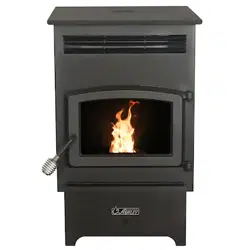Loading ...
Loading ...
Loading ...

© 2021 United States Stove Company
9
7. Outside Fresh Air is Mandatory when
installing this pellet stove room heater in
airtight homes and mobile homes. Be sure
that the outside air vent has an approved
cap on it to prevent rodents from entering.
Be sure to install in location that won’t
become blocked with snow, etc.
8. Connect the exhaust vent pipe to the exhaust
outlet of your pellet stove.
9. Secure all vent joint connections with 3 screws.
Seal the exhaust vent joint connections with
high temperature silicone sealant.
10. Push the unit straight back to the interior
wall, being sure to maintain the minimum
clearances to combustibles 2” (51 mm) to the
back of the unit. Seal the annular space of the
wall thimble and around the vent pipe with
high temperature silicone sealant.
11. The exhaust vent pipe must extend at least 12”
(300 mm) out past the exterior wall. Seal the
annular space of the wall thimble and around
the vent pipe with high temperature silicone
sealant.
12. Install an approved horizontal termination cap or
if necessary install a 90° elbow and appropriate
length of vertical venting. An approved vertical
vent cap is recommended.
THROUGH THE WALL INSTALLATION
(RECOMMENDED INSTALLATION)
Canadian installations must conform to CAN/
CSA-B365. To vent the unit through the wall,
connect the pipe adapter to the exhaust motor
adapter. If the exhaust adapter is at least 18” (457
mm) above ground level, a straight section of
pellet vent pipe can be used through the wall.
Your heater dealer should be able to provide you
with a kit that will handle most of this installation,
which will include a wall thimble that will allow
the proper clearance through a combustible
wall. Once outside the structure, a 3” (76 mm)
clearance should be maintained from the outside
wall and a clean out tee should be placed on the
pipe with a 90-degree turn away from the house.
At this point, a 3ft (0.91m) (minimum) section of
pipe should be added with a horizontal cap, which
would complete the installation. A support bracket
should be placed just below the termination cap
or one every 4ft (1.22m) to make the system more
stable. If you live in an area that has heavy snowfall,
it is recommended that the installation be taller
than 3ft (0.91m) to get above the snowdrift line.
This same installation can be used if your heater is
below ground level by simply adding the clean-out
section and vertical pipe inside until ground level is
reached. With this installation you have to be aware
of the snowdrift line, dead grass, and leaves. We
recommend a 3ft (0.91m) minimum vertical rise on
the inside or outside of the house. The “through the
wall” installation is the least expensive and simplest
installation. Never terminate the end vent under a
deck, in an alcove, under a window, or between two
windows. We recommend Simpson Dura-Vent® or
Metal-Fab® kits.
TYPICAL THROUGH THE
WALL INSTALLATION
THROUGH THE ROOF/CEILING
INSTALLATION
• When venting the heater through the ceiling, the
pipe is connected the same as through the wall,
except the clean-out tee is always on the inside
of the house, and a 3” (76 mm) adapter is added
before the clean-out tee.
• You must use the proper ceiling support
anges and roof ashing (supplied by the pipe
manufacturer; follow the pipe manufacturer’s
directions). It is important to note that if your
vertical run of pipe is more than 12ft (3.7m), the
pellet vent pipe size should be increased to 4” (102
mm) in diameter.
• Do not exceed more than 4ft (1.22m) of pipe on a
horizontal run and use as few elbows as possible. If
an offset is required, it is better to install 45-degree
elbows rather than 90-degree elbows.
INSTALLATION
Loading ...
Loading ...
Loading ...
